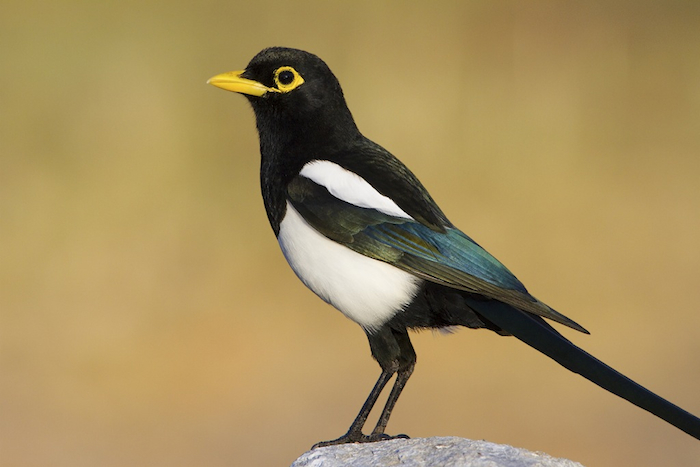
Yellow-billed Magpie photo by David Bogener
Endemic. It means they live nowhere else in the world–and we’re lucky enough to have a beautiful California endemic right here!
Yellow-billed magpies live in a swath from Redding down to Santa Barbara. They are seldom seen away from the scattered large oaks of that stretch, and never seen outside the state, where they leave the turf to their black-billed relatives.
The only thing not beautiful about these birds is their voice, a chatter variably squeaky and raspy. But visually, from yellow bill to long, graceful tail, they are striking. Clean white shoulders and belly offset their silky black feathering, which in good light shines with a deep cerulean blue. Their wingbeat, for a bird as tough as magpies, has a gossamer flow to it. If a group of crows is called a murder, we should speak of a waltz of magpies! And they look at you as if they know what they’re doing—as well they might.
Magpies, jays, and crows are part of a family of birds known as corvids. Like people, corvids usually live in social groups—not synchronized flocks, but neighborhoods of individuals. Also like people, they can physically manipulate their environment—people with opposable thumbs, corvids with long, hefty, all-purpose bills. These physical and social characteristics seem to promote problem-solving in creatures as varied as parrots, wolves, dolphins, and apes.
Corvid studies have shown these birds to far surpass Harvard students in remembering where they have hidden acorns. But their thinking gets more complex, too. Crows—much more studied than magpies–are socially and mechanically adept. Those who have pilfered other crows’ acorn stash will bury the food but then re-hide it when their chums aren’t looking! As mechanical engineers, they have replicated Aesop’s old fable—not only getting a drink by dropping pebbles in a vase to raise the water level, but dropping pebbles to raise a floating piece of meat, and declining to drop pebbles to retrieve the meat in a vase half-filled with sand instead of water.
Alas, corvid intelligence cannot solve all problems. West Nile virus has hit these birds particularly hard, and magpies show almost no development of resistance. I very rarely see them on the Shasta College campus or at Lake Redding any more. Magpie families can still be seen at Kutras Pond and Anderson River Park. There they continue to prosper in the mix of tall oaks, open ground, and nearby water. They forage in the fields for bugs, seeds, lizards, or dropped sandwiches; they crack and eat acorns, and reportedly they will even pick insects off a deer’s back.
The oaks offer magpies elevated roosts and nesting sites, where they build their little towns of stick-and-mud nests with domed roofs. They line the interior with softer materials such as hair or grass, and there they raise their half-dozen nestlings each year.
But as for so many birds, a looming threat to those nestlings is climate change. Yellow-billed magpies are expected to lose over half their range by 2050. That’s a problem that neither corvid intelligence nor any other has yet resolved.

